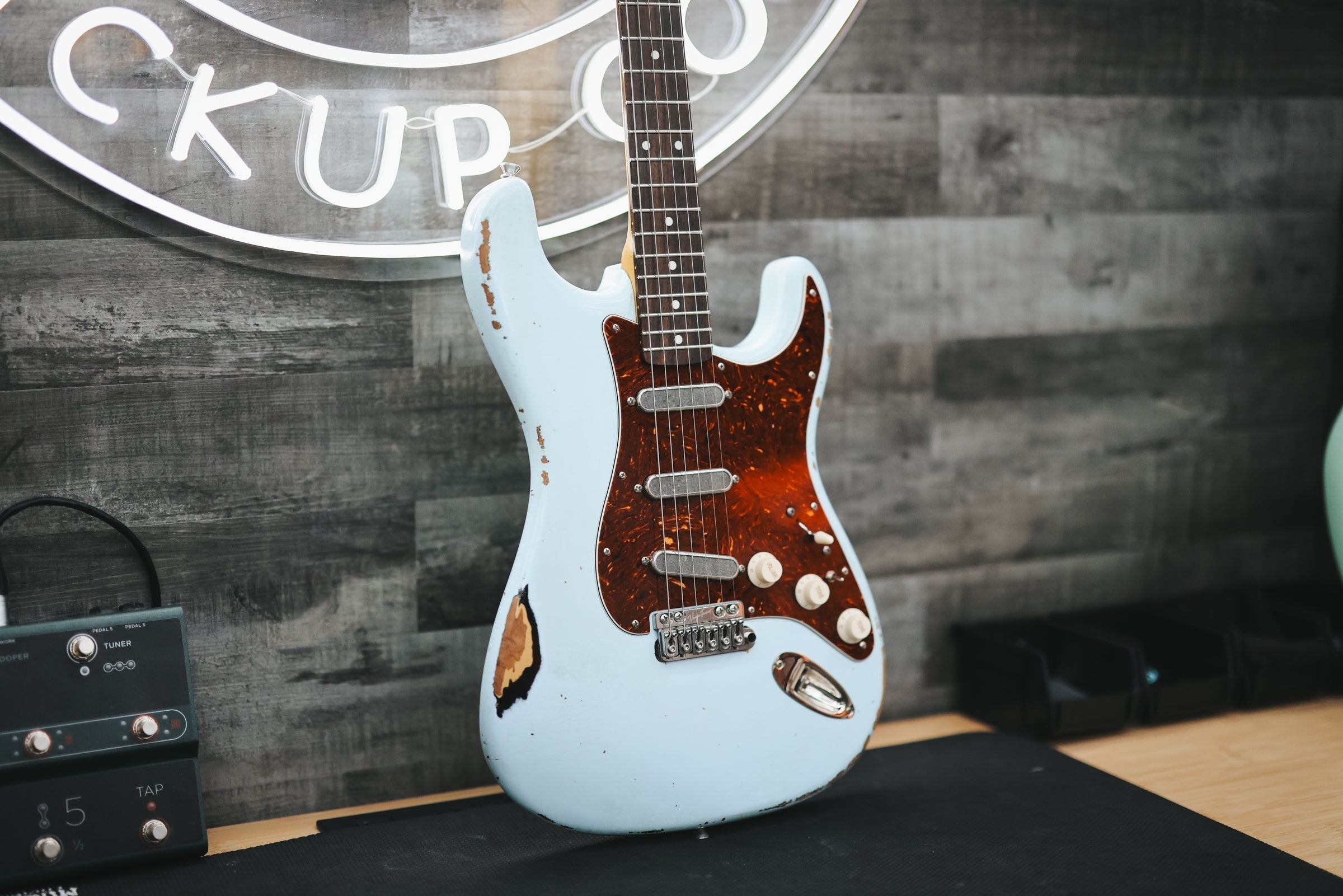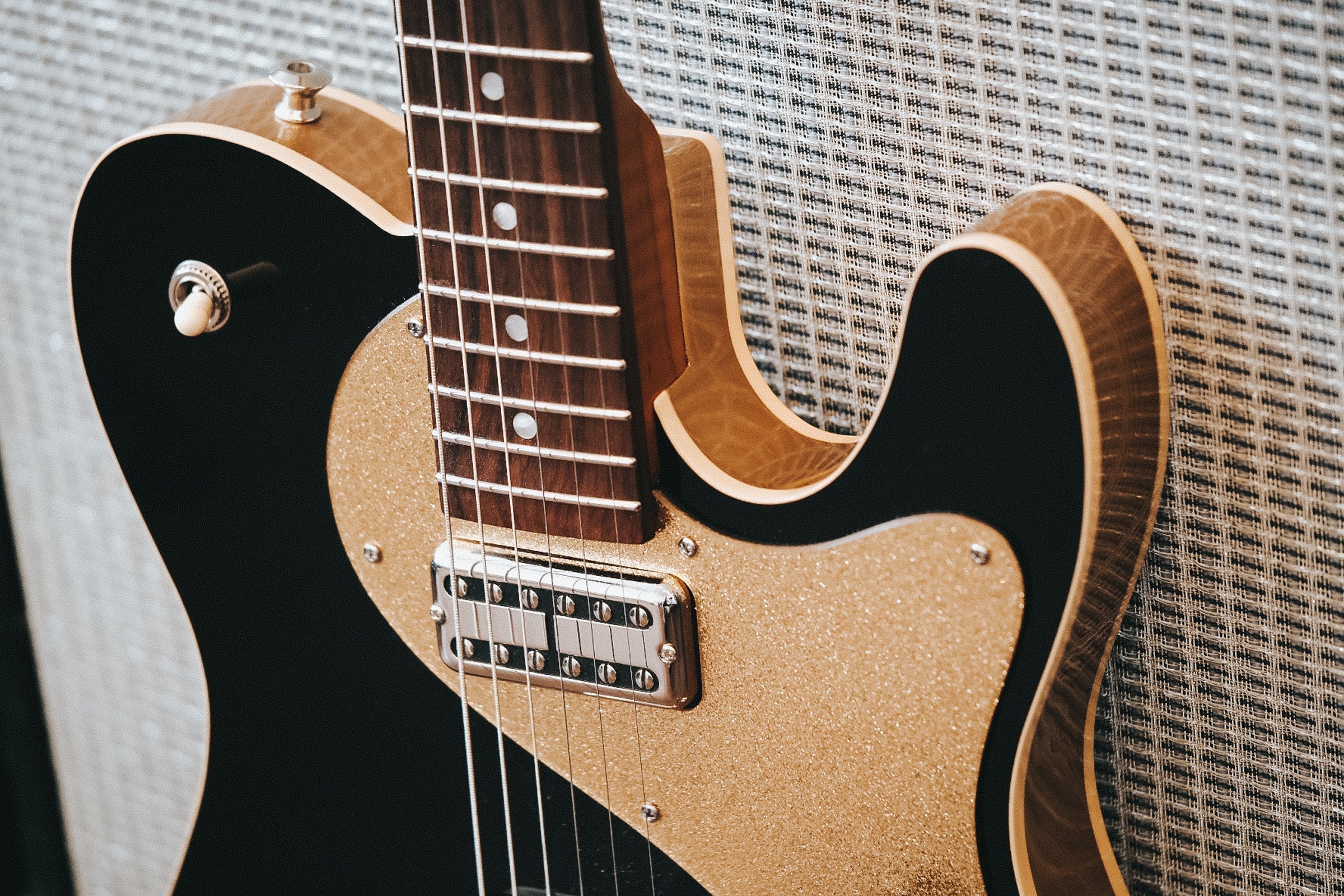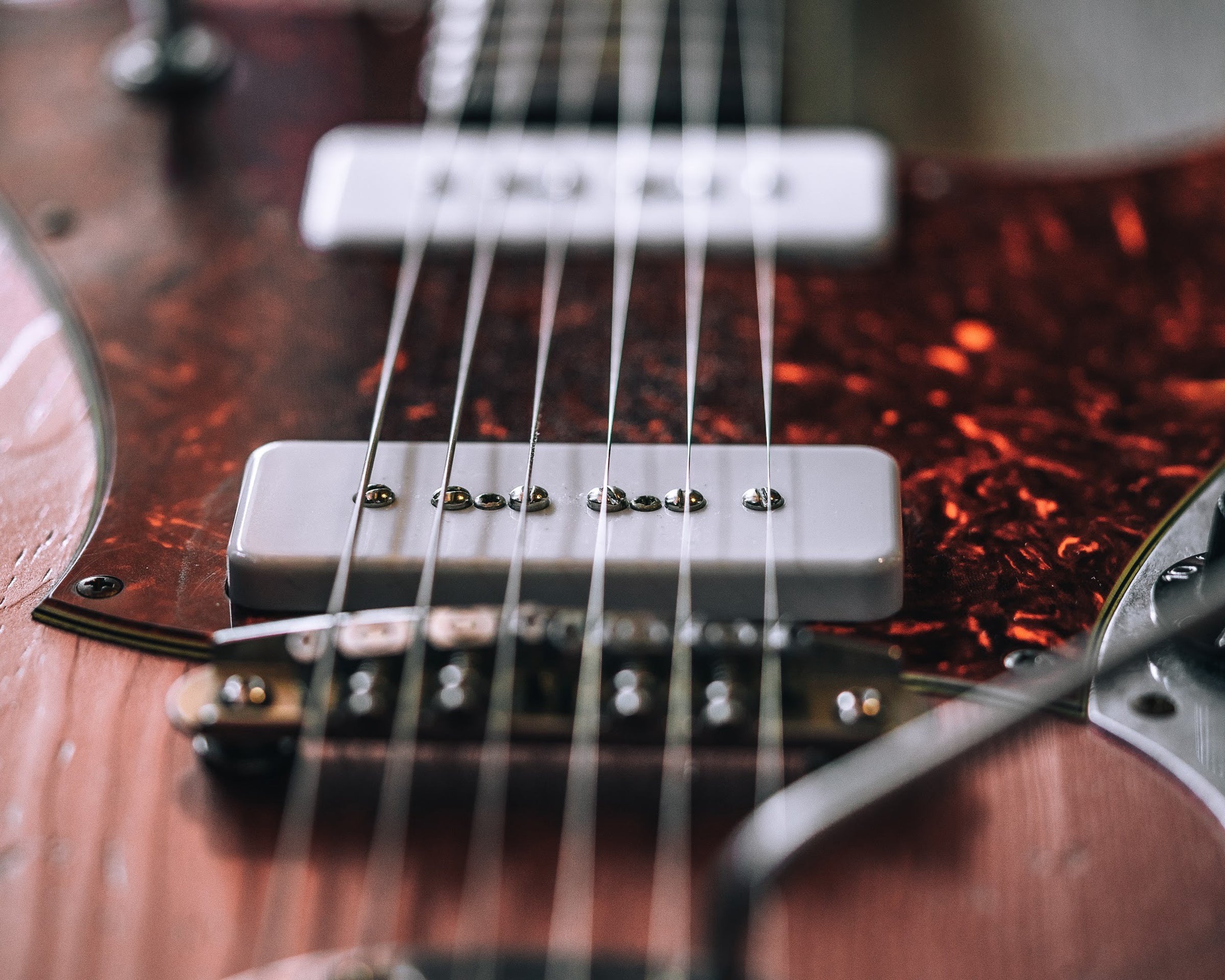
What Is A Baritone Guitar
Some of you know I'm a drummer, but I have been messing around with guitars for nearly 30 years. One thing I love is how many different forms this instrument can take. I started with a wide-necked classic six-string nylon acoustic guitar and then jumped to a screaming electric shred machine of an intro level SG-style Ibanez, to a bright blue Strat, then a Godin Solidac, and mannnnny more.
Guitars come in all shapes, sizes, and sounds. Each type of guitar has its own character and tone, and exploring these differences is part of the fun. Understanding the quirks of each instrument can help you find the one (yeah, right, like that's possible) that suits your style and preferences best. In this post, I want to share about a less common member of the guitar family, the baritone guitar. We’ll dive into what a baritone guitar is, talk about how it looks and feels, and explore its unique sound. By the end, you’ll know how a baritone compares to a regular guitar, what genres of music it’s used in, and even how to tune a baritone guitar properly. Let’s get started on this tone journey dedicated to the baritone guitar.

What Is A Baritone Guitar
A baritone guitar is built to reach lower notes than a standard guitar. At first glance, it looks similar to a regular guitar; typically, it has six strings (sometimes seven) and the same general shape. However, a baritone has a longer scale length (a longer neck and distance from the bridge saddles to the nut), allowing the strings to be tuned lower without getting floppy. For example, many baritone guitars have a scale length around 27 inches or more, compared to the 24" short scale Jaguar, 24.75" Gibson scale, 25" PRS scale, and 25.5 inch scale of a typical Fender Stratocaster. The longer neck and heavier strings give the baritone its signature lower register.
The baritone guitar sits in a unique spot between a normal guitar and a bass guitar. In fact, it was designed to bridge the gap between a standard six-string guitar and a six-string bass. A baritone is tuned lower than a normal guitar, but not as low as a bass guitar. Most baritones are tuned a perfect fourth below standard tuning. Let's get practical, while a standard guitar is tuned (low to high) E–A–D–G–B–E, a typical baritone guitar is tuned B–E–A–D–F♯–B (this is known as B standard tuning). That B standard tuning is five semitones lower than the regular guitar. Some baritone players go even deeper and use A standard (A–D–G–C–E–A, a perfect fifth down) or C standard (C–F–A♯–D♯–G–C, a major third down). The cool thing is that despite the lower pitch, the intervals between strings are the same as on a regular guitar, so you can play the same chord shapes and scales, they’ll just come out sounding in a lower sonic frequency space. Many players report that when they play known licks on a baritone it can be very inspiring!
Physically, a baritone guitar usually has a bigger body or longer neck to accommodate the longer strings. If it’s an electric baritone guitar, it might look like a slightly oversized Strat, Tele, or any other familiar model, just scaled up a bit. Acoustic baritone guitars exist as well – these are acoustic guitars built to the baritone scale, which produce a very rich, deep acoustic sound (artists like Dave Matthews have even used acoustic baritone guitars in their sets). Whether electric or acoustic, baritone guitars use thicker gauge strings (often starting around .013 or .014 on the high end) to maintain proper tension at the lower tuning intervals. Without those heavier strings and longer neck, a guitar tuned that low would feel like wet spaghetti when you play – not good for tone or playability! To wrap up this section, baritone guitars are specialized instruments with a longer scale length and lower tuning than a standard guitar, giving it a uniquely deep voice while still feeling like a guitar.
You can get baritone-specific strings from most string manufacturers; we prefer StringJoy. Save 10% off your strings order using code: LAMBERTONES

What Does A Baritone Guitar Sound Like
So, what does a baritone guitar sound like? In a few words: deep, thick, resonant. The baritone’s tone is thicker and warmer than a regular guitar. Those lower notes have a richness and resonance that you might not get from a standard guitar. Many players describe baritone guitars as sounding rich, warm, and full, with a dynamic range that adds power to the low end. Because of the increased string tension from the longer scale, baritones often have great sustain, which means that notes ring out nicely and long, giving chords a lush, ringing quality perfect for ambient style tones and paired beautifully with reverb. Strumming an open chord on a baritone guitar can almost sound piano-like in fullness, because you’ve got that extra low range along with the higher strings.
You can approach playing it in multiple ways, but if you play single-note lines on the low strings and you get a twangy, thick tone that’s great for anything from surf rock riffs to spaghetti western ambiance. If you’ve ever watched an old western movie and heard that low spaghetti western guitar twang drenched in reverb, that sounds like a baritone guitar producing those haunting notes. On the flip side, if you play higher up the neck or use a capo, a baritone can mimic a regular guitar but with a somewhat darker color to the tone.

What Is A Baritone Guitar Used For
Baritone guitars may not be as common as standard guitars, but they’ve found a home in many genres of music thanks to their unique sound. Here are some of the most common uses and musical styles where a baritone guitar really shines:
Surf Music and Spaghetti Westerns:
The baritone’s low, twangy sound became a signature in early surf rock and western film scores. In the late 1950s and 60s, guitarists like Duane Eddy helped popularize the baritone by using it for instrumental rock and surf tunes, cranking out low-end riffs with that “twangy” vibe. The Beach Boys’ Brian Wilson famously used baritone guitars to get those fat, bass-heavy guitar lines that drove the surf music sound of the early ’60s. And if you’ve ever heard the theme from The Good, the Bad and the Ugly or other classic spaghetti westerns, you’ve heard a baritone guitar's deep notes drenched in reverb creating that iconic Wild West atmosphere.
Rock and Metal:
Ever since the 1980s, rock and metal players have embraced baritone guitars tuned down for heavier music. The baritone guitar can handle drop tunings and ultra-low riffs with ease, thanks to its longer scale and thick strings. Bands in genres like thrash, doom, and progressive metal use baritones for their extended range so they play riffs lower than standard tuning without the strings turning too slinky. Notable guitarists like Dino Cazares of Fear Factory or Mark Holcomb of Periphery have signature baritone models to accommodate their low-tuned shredding. Even in hard rock, baritones are used for that extra growl. Van Halen, for example, had a custom double-neck baritone he used live on the song “Spanked.” If you want heavy, chunky guitar tones that border on a bass’s territory, the electric baritone guitar is the tool for the job.
Pop, Indie and Other Genres:
Outside of the obvious genres, baritones are used anywhere an artist wants a unique tone. In indie and alternative music, a baritone can provide a moody, rich texture. For instance, indie singer-songwriter Phoebe Bridgers uses a baritone guitar to give her songs a deep, haunting vibe. In pop and rock, Glen Campbell’s hits like “Wichita Lineman” and “Galveston” featured baritone guitar solos for extra drama. Some modern players use electric baritone guitars with lots of reverb and delay to create ambient soundscapes, while others, like Dave Matthews, have incorporated acoustic baritone guitars for a deeper rhythmic foundation in band arrangements.

How To Tune A Baritone Guitar
Tuning a baritone guitar is a bit different from tuning a standard guitar because of that lower pitch range. It's not difficult, so just make a note of the different tuning notes, and after a couple of times, you'll get the hang of it! Here are some tips (and steps) on how to tune a baritone guitar:
1. Understand Standard Baritone Tuning (Choose Your Tuning)
First things first, decide on what tuning you want for your baritone. The most standard tuning for a six-string baritone guitar is B standard. This means the open strings, from lowest (6th string) to highest (1st string), will be: B–E–A–D–F♯–B. That tuning is a perfect fourth below a normal guitar’s E–A–D–G–B–E. In other words, if you take all the strings of a regular guitar and tune them down by a perfect fourth, you get B standard. One cool aspect of B standard is that all your chord shapes and scales from a standard guitar still work; they’ll just sound lower. For example, an open E chord shape on a baritone actually yields a B chord in this tuning.
Besides B standard, some players tune even lower. A standard (A–D–G–C–E–A) is a whole step down from B standard (a perfect fifth below a regular guitar’s E), and C standard (C–F–A♯–D♯–G–C) is a step up from B (a major third below a regular guitar). Most baritone guitars can handle these common baritone tunings. If you’re not sure, B standard is a great starting point for that classic baritone sound.
2. Use the Right Strings and Setup
Make sure your baritone is strung with proper strings. Baritone guitars require heavier string gauges than a standard guitar to achieve lower tunings with the right tension. Typically, baritone string sets might range from .013 or .014 on the high E (1st string) and go up to .062 or even thicker on the low B. Using the correct baritone guitar strings is important – if you try to tune a regular light gauge guitar string down to B, it will become very loose and floppy, making the guitar hard to play and likely causing fret buzz.
The combination of the longer scale length and heavier strings keeps the tension feeling normal even when the guitar is tuned way down. Also, check your guitar’s setup: with thicker strings, you might need to widen the nut slots slightly or adjust the truss rod for the added tension. If you bought a baritone guitar new, it should already be set up for baritone tuning. If you’re converting a standard guitar to baritone tuning (an adventurous experiment!), definitely get it set up by a pro so it can handle the tension and lower pitch.
3. Tune Each String to the Correct Pitch
Grab your tuner (a chromatic tuner or guitar tuner app works well) and tune each string to your chosen pitches. Let’s assume B standard for this example. Starting from the lowest string (the sixth string), tune it down to B. This B is two and a half steps below the normal low E. A handy reference: B is the note a perfect fourth below E. Next, the fifth string tunes to E (which is a fourth below the standard A). The fourth string goes to A (a fourth below the standard D). The third string becomes D (down from G). The second string becomes F♯ (down from B). And finally, the first string tunes to B (down from high E). It’s a good idea to lower the pitch gradually because these baritone strings are thick and can be a bit stiff, so make small adjustments and give the string a moment to settle.
4. Check Intonation and Playability (Maintenance Tips)
After you’ve got the baritone tuned up (or rather, down) to pitch, it’s wise to check a couple of things. First, play some notes up and down the fretboard to check the intonation. If the 12th fret notes are wildly out of tune compared to the open strings, you might need to adjust the bridge saddles slightly. Baritone guitars usually come intonated for baritone tuning, but if you changed string gauges or tuning, a tweak might be needed so that chords sound in tune across the neck. Next, pay attention to the neck relief and action. The longer scale length and heavy strings mean there’s a lot of tension on the neck. If you feel the action (string height) is too high or too low after tuning, you might have to adjust the truss rod or bridge. Hopefully, if your guitar was set up for baritone from the start, it should play comfortably once tuned up.

One important safety tip: never try to tune a baritone guitar up to standard guitar tuning using baritone strings. Those thick strings at high tension could put excessive strain on the guitar neck. Guitar builders warn that baritone guitars with baritone string sets should never be tuned up to standard E tuning, as it could potentially damage the instrument. Always keep the guitar tuned to baritone ranges (B, A, etc.) unless you swap out for lighter strings and do a proper setup.
Lastly, once you’re tuned, take a moment to stretch your strings gently and re-tune. New strings, in particular, will stretch out a bit after the first tuning. By giving them a slight tug and retuning, you’ll help the guitar stay in tune better when you start playing. If you want to know more about how to lower the action and setup your guitar you can check out this post. Now you’re all set and your baritone is tuned and ready to rip! Play a few of your favorite songs (they’ll sound extra chunky and cool in the lower register) and enjoy that deep baritone guitar tone, letting it inspire you to try new phrases and chord shapes as the sonic frequencies collide with your ears in a different way. As guitar players we're always looking for ways to feel inspired. Sometimes that's with a new pedal, a new plugin or amp capture, or maybe its a different scale length of guitar like the baritone - bringing a new perspective in your tone. Thanks for reading and love your tone!



Leave a comment
This site is protected by hCaptcha and the hCaptcha Privacy Policy and Terms of Service apply.